 Italy
Italy
PhD topic: Maar diatreme system in Hopi Buttes, Navajo Nation, AZ, USA
Supervisors:James White, Christian Ohneiser
Email: regi7084 (at) student.otago.ac.nz
Phd project
How are eruptions of small volcanoes initiated and modulated by the dikes and conduits of their feeder system?
Supervisor: Dr. James D.L. White (Prof. Ass. University of Otago)
Small-volume volcanoes are generally dominated by multiple explosive magma-water interaction; most of these volcanoes are monogenetic, having only a single eruptive episode before becoming extinct. This is because magma supply is so small or episodic that any pathways have cooled down and are no longer favored routes for the next magma batch.
Maars landforms results as a deep volcanic crater, which his bottom is cut below the pre-eruptive ground surface, and is surrounded by a low profile thepra ring. They tipically range between 100s of meters to >1 km.
Underneath the maar crater is sat a diatreme, a funnel-shape subterranean structure wide at the top and narrow at the base; diatremes are cut into the country rock (or soft deposits) and filled by pyroclastic debris and broken-up country rock (Lorenz, 1986; White and Ross, 2011). They tipically extend downward, below original ground level, from 100s of meters to few km. Diatremes often consist of three zones (White and Ross, 2011): (1) the upper diatreme, consisting of bedded lapilli tuffs and tuff breccias that sometimes have inward (toward the center of the diatreme) dips that steepen with depth; (2) the lower diatreme, consisting of relatively massive tuff breccia with crosscutting, subvertical contacts separating tuff breccias of varying clast compositions, in some cases containing isolated slabs or fragmental domains of country rock or ejecta rim derived from higher levels; and (3) the root zone, where primary volcaniclastic deposits (White and Houghton, 2006) are cut by irregularly shaped intrusive bodies, commonly surrounded by in situ country rock breccia, and merge downward into coherent feeder dikes.
Observations of historical maar eruptions (eg.: Lorenz, 1986; White and Ross, 2011) shows that maars and their tephra rings, and by implication diatremes, are formed by many discrete phreatomagmatic eruptive pulses (reflecting individual explosions), which sometimes combine into more sustained eruptive phases (e.g., Moore et al., 1966). However, processes that form diatremes and occur inside them are not yet agreed upon, and the locations of explosion sites in the diatreme and relationship between diatreme and tephra ring evolution remain uncertain (Valentine and White, 2012).
Diatremes and root zones are commonly exposed where extinct mafic to ultramafic volcanic fields have been eroded to expose the plumbing of the volcanoes. Hopi Buttes volcanic field (HBVF), in the Navajo Nation Arizona, contains magnificent exposures of frozen plumbing systems extending over ~2 km2; located on the stucturally unmodified Colorado Plateau it consist of about 300 maars-diatremes volcanoes and minus scoria cones of a late Miocene age (~7 Ma; M. Ort et al. in review) fed by dike systems. The gradual increase in the depth of erosion from the North to the South across the field offer a progressively exposure of the different zones of these volcanoes.
This work take in account volcanic feature located at the Jagged Rock, in the southern of the HBVF (Fig. 1). On the first stage we will focus the attention on the role played by feeder dykes in the development of the eruption.
From continuum-mechanical models for host-rock deformation, Delaney and Pollard (1981) argue that the initial emplacement of magma is in a dike composed of discontinuous echelon segments; wallrock is fractured and comminuted to breccias subsequently eroded by flowing magma. To focus the flow, dikes may grew into buds, plugs or volcanic necks by further erosion of the wallrocks; so, they conclude that dike propagation was the dominant mechanism for creating conduits for magma ascent where the host rock is brittle and elastic.
The aim will be to determine in which way dykes feed magma to surface eruptions, and the onset of fragmentation and conduit development for small basaltic volcanoes in general. In particular, what is it that makes in the same field some volcanoes erupt explosively and make deep diatremes, while others erupt quietly to form scoria cones and lava flows? Differences in dike/conduit characterists within the hydrologically uniform Hopi Buttes field show that it is not as simple as some parts of the dike hit groundwater while others so not.
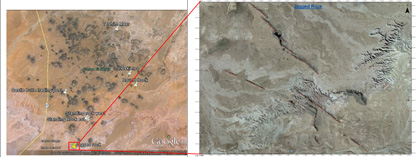
Fig.1: Locality of Jagged rock in the HBVF. Volcanic feature recognized from preliminary study.
There are evidence that shallow country rock played an important role in behaviour of feeder dikes, that spawn at particular levels. Furthermore, country rock rheology plays a role in facilitating near-surface (upper km) diversion of magma from dikes into sills; where these diversions occurred magma flux reduced, allowing differentiation with changes in magma evolution from early dikes.
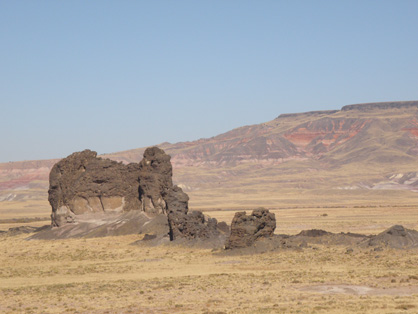
Fig.2: Volcanic plug at Jagged rock.
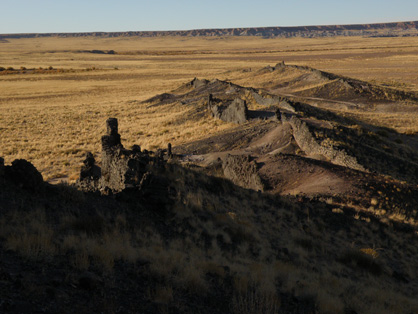
Fig.3: En echelon dykes swarm, typical features at Jagged rock.
References
- Delaney P.T. and Pollard D.D., (1981). Deformation of host rocks and fl ow of magma during growth of minette dikes and breccia-bearing intrusions near Ship Rock, New Mexico. U.S. Geological Survey Professional Paper 1202: 1–61.
- Lorenz V. (1986). On the growth of maars and diatremes and its relevance to the formation of tuff rings. Bull Volcanol 48:265-274
- Valentine G.A., White J.D.L. (2012). Revised conceptual model for maar-diatremes: Subsurface processes, energetics, and eruptive products. Geology:10.1130/g33411.33411
- White J.D.L., Ross P.S. (2011). Maar-diatreme volcanoes: A review. J Volcanol Geoth Res 201(1–4):1-29
Master thesis
Secche di Lazzaro pyroclastics (Stromboli): new insight and old interpretation.
Supervisors: Dr. M. Rosi (University of Pisa), Dr. A. Bertagnini (INGV-Pisa), Dr. P. Landi (INGV-Pisa)
Poster session: MeMoVolc Summer School “Volcanic ash: from magma to aviation” 25-29 June 2012, Nicolosi (CT)
Stromboli, since its remote mergence from the Tyrrenian Sea, has a turbulent eruptive history characterized by violent explosions, devasting collapses and rapid vigorous recostructions.
The "Secche di Lazzaro pyroclastics" (SLP) is a succession consisted of thinly bedded plane-parallel fine-ash tuff layers, interposed with massive and chaotic deposit (Bertagnini e Landi, 1996). At its type locality, placed on the SW cost of the island close to the small village of Ginostra, SLP overlies Neostromboli lava's (13 to 5 ky B.P. Hornig-Kjarsgaard et al., 1993).
Six outcrops widespread on the island slope (Fig.1) are studied during this work to assess the affinity with the SLP type succession; despite of difference in the stratigraphic log succession, they show similar sedimentological and volcanological features.
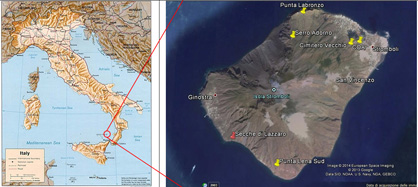
Fig.1: SLP outcrops scattered on Stromboli island; in red the type locality.
Investigations are developed both on the field and in laboratory, and involve stratigraphic reconstruction and interpretation, grain size distribution and component analysis of tephra layers, petrographic description of main component, chemistry of juvenile glass matrix (SEM), chemistry of whole rock.
In particular, main similarity concern:
i) stratigraphic position above Neostromboli's lavas, whitout paleosol interposition; exceptions exist for Punta Lena, COA and Cimitero Vecchio outcrops;
ii) stratigraphic successions consist in alternation of fine ash fall-out layers and debris flow deposits;
iii) every succession has clear phreatomagmatic characteristic;
iv) occurrence of huge amount of very fine ash, often aggregated to form a great abundance accretionary lapilli;
v) narrow compositional range of major elements in juvenile glass matrix, coherent with Neostromboli KS series;
vi) comparable distribution of vulcanoclastic components that show, from the bottom to the top of sequences, an increasing amount of intrusive (Renzulli et al., 1997) and alterated (oxidation and/or hydrotermally) clast, and a decrement of lithic lava's and juvenile.
Main uncertainties are due to the high steepness of volcano's slope that, implying an high energy erosion processes, do not allow a wide spread of outcrops also compromising its lateral continuty.
In addition, other problems are exibited in the following works cited:
i) different interpretation of volcanological record (Porreca et al., 2006; Giordano et al., 2008);
ii) slightly isotopic differences on the glass matrix of juvenile component (Petrone et al., 2009);
iii) diverged dating on the spatter lavas substrate of COA (6,2 ka BP Speranza et al., 2008; 12,5 ka BP Calvari et al., 2010).
Overall, despite of currently diparate ideas, features highlighted during this study suggest that these successions represent a different display of the same eruption on various volcano's sector.
SLP activity is related to a large scale phreatomagmatic explosion which represents the most powerful activity of the last 6 ky, marking the end of Neostromboli cycle, that trigger or was triggered by the Sciara del Fuoco sector collapse on the NW flank of the island..
This was a multiphase eruption; several phreatomagmatic explosions happened, with a progressive deepening of the fragmentation zone, as shown from the lithic distribution. The excavation of the edifice might reflect the occurrence of a multiple regressive landslide event, which in the late stage intersect the core of the hydrotermal system (Bertagnini e Landi, 1996).
In addition, it could not be excluded the opening of lateral vent on the Stromboli's flank.
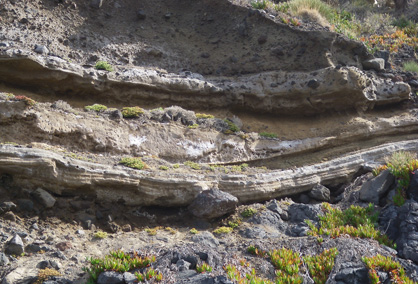
Fig.2: Pyroclastic succession at Secche di Lazzaro.
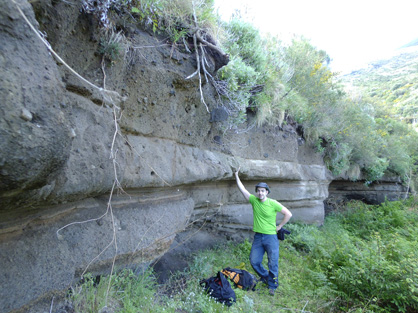
Fig.3:Pyroclastic succession at COA (Operative Advance Centre) locality
References
- Bertagnini A., Landi P. (1996). The Secche di Lazzaro pyroclastic of Stromboli volcano: A phreatomagmatic eruption related to the Sciara del Fuoco sector collapse. Bull. Volcanology, 58: 239–245
- Calvari S., Branca S., Corsaro R.A., De Beni E., Miraglia L., Norini G., Wijbrans J., Boschi E. (2011). Reconstruction of the eruptive activity on the NE sector of Stromboli volcano: timing of flank eruptions since 15 ka. Bull. Volcanology, 73:101–112
- Giordano G., Porreca M., Musacchio P., Mattei M. (2008). The Holocene Secche di Lazzaro phreatomagmatic succession (Stromboli, Italy): evidence of pyroclastic density current origin deduced by facies analysis and AMS flow direction Bull. Volcanology, 70: 1221–1236
- Hornig-Kjarsgaard I., Keller J., Koberski U., Stadlbauer E., Francalanci L. and Lenhart R. (1993). Geology, stratigraphy and volcanologicalevolution of the island of Stromboli, Aeolianarc, Italy. Acta Vulcanologica, 3: 21-68.
- Petrone C.M., Braschi E., Francalanci L. (2009). Understanding the collapse–eruption link at Stromboli, Italy: A microanalytical study on the products of the recent Secche di Lazzaro phreatomagmatic activity. Journal of Volcanology and Geothermal Research 188: 315-322
- Porreca M., Giordano G., Mattei M., and Musacchio P. (2006). Evidence of two Holocene preatomagmatic eruptions at Stromboli volcano (Aeolian Islands) from paleomagnetic data. Geophys. Res. Lett., 33, L21316
- Renzulli A., Santi P. (1997). Sub-volcanic crystallization at Stromboli (Aeolian Islands, Southern Italy) preceding the Sciara del Fuoco sector collapse: evidence from monzonite lithic suite. Bull. Volcanology, 59: 10–20
- Speranza F., Pompilio M., D'Ajello Caracciolo F., Sagnotti L (2008). Holocene eruptive history of the Stromboli volcano: constraints from paleomagnetic dating. Jour Geoph Res 113:1–23